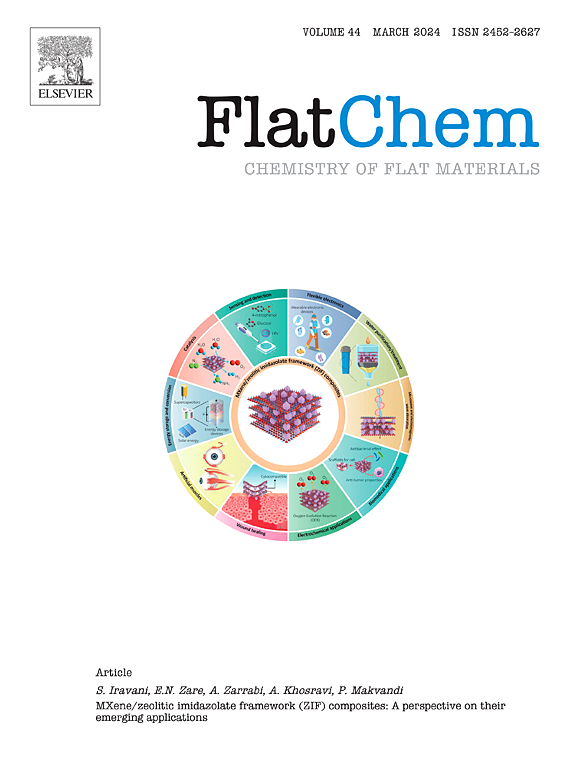通过化学气相沉积在密闭空间中扩散控制二维WSe2生长的机理
IF 6.2
3区 材料科学
Q2 CHEMISTRY, PHYSICAL
引用次数: 0
摘要
二维过渡金属二硫族化合物(TMDs)因其在电子和光电子器件中的潜力而受到广泛关注。虽然化学气相沉积(CVD)是生产大面积单层tmd的主要技术,但使用具有高熔点的金属氧化物前驱体存在各种合成限制。作为替代方案,金属盐基前体由于其水溶性和低熔点而出现。然而,从这些液体前体中获得高质量的tmd仍然存在挑战,这主要是由于对前体扩散过程的了解有限。在此,我们系统地研究了基于自旋涂层前驱体的WSe2在密闭空间中的CVD生长,证明了通过衬底覆盖来调节前驱体扩散,可以显著增强结构域尺寸和数量密度的均匀性。此外,我们还表明,在薄片边缘内外的微观前驱体扩散会影响边缘形态和局部光学发射特性。这些发现为大面积TMD单层材料的制造提供了有价值的见解,这对电子和光电子应用具有前景。本文章由计算机程序翻译,如有差异,请以英文原文为准。

Mechanistic insights into diffusion-controlled 2D WSe2 growth via chemical vapor deposition in confined spaces
Two-dimensional transition metal dichalcogenides (TMDs) have garnered significant attention for their potential in electronic and optoelectronic devices. While chemical vapor deposition (CVD) is a primary technique for producing large-area monolayer TMDs, the use of metal oxide precursors with high melting points presents various synthetic limitations. As an alternative, metal salt-based precursors have emerged due to their water solubility and low melting points. However, challenges remain in obtaining high-quality TMDs from these liquid precursors to, largely due to a limited understanding of the precursor diffusion process. Here, we present a systematic study on spin-coated precursor-based CVD growth of WSe2 in confined spaces, demonstrating a significant enhancement in the uniformity of domain size and number density through regulated precursor diffusion achieved by substrate covering. Furthermore, we show that microscopic precursor diffusion, both within and beyond the flake edges, influences edge morphologies and local optical emission properties. These findings provide valuable insights into the fabrication of large-area TMD monolayers, which hold promise for electronic and optoelectronic applications.
求助全文
通过发布文献求助,成功后即可免费获取论文全文。
去求助
来源期刊

FlatChem
Multiple-
CiteScore
8.40
自引率
6.50%
发文量
104
审稿时长
26 days
期刊介绍:
FlatChem - Chemistry of Flat Materials, a new voice in the community, publishes original and significant, cutting-edge research related to the chemistry of graphene and related 2D & layered materials. The overall aim of the journal is to combine the chemistry and applications of these materials, where the submission of communications, full papers, and concepts should contain chemistry in a materials context, which can be both experimental and/or theoretical. In addition to original research articles, FlatChem also offers reviews, minireviews, highlights and perspectives on the future of this research area with the scientific leaders in fields related to Flat Materials. Topics of interest include, but are not limited to, the following: -Design, synthesis, applications and investigation of graphene, graphene related materials and other 2D & layered materials (for example Silicene, Germanene, Phosphorene, MXenes, Boron nitride, Transition metal dichalcogenides) -Characterization of these materials using all forms of spectroscopy and microscopy techniques -Chemical modification or functionalization and dispersion of these materials, as well as interactions with other materials -Exploring the surface chemistry of these materials for applications in: Sensors or detectors in electrochemical/Lab on a Chip devices, Composite materials, Membranes, Environment technology, Catalysis for energy storage and conversion (for example fuel cells, supercapacitors, batteries, hydrogen storage), Biomedical technology (drug delivery, biosensing, bioimaging)
 求助内容:
求助内容: 应助结果提醒方式:
应助结果提醒方式:


